Cofactor F420: an expanded view of its distribution, biosynthesis and roles in bacteria and archaea
- PMID: 33851978
- PMCID: PMC8498797
- DOI: 10.1093/femsre/fuab021
Cofactor F420: an expanded view of its distribution, biosynthesis and roles in bacteria and archaea
Abstract
Many bacteria and archaea produce the redox cofactor F420. F420 is structurally similar to the cofactors FAD and FMN but is catalytically more similar to NAD and NADP. These properties allow F420 to catalyze challenging redox reactions, including key steps in methanogenesis, antibiotic biosynthesis and xenobiotic biodegradation. In the last 5 years, there has been much progress in understanding its distribution, biosynthesis, role and applications. Whereas F420 was previously thought to be confined to Actinobacteria and Euryarchaeota, new evidence indicates it is synthesized across the bacterial and archaeal domains, as a result of extensive horizontal and vertical biosynthetic gene transfer. F420 was thought to be synthesized through one biosynthetic pathway; however, recent advances have revealed variants of this pathway and have resolved their key biosynthetic steps. In parallel, new F420-dependent biosynthetic and metabolic processes have been discovered. These advances have enabled the heterologous production of F420 and identified enantioselective F420H2-dependent reductases for biocatalysis. New research has also helped resolve how microorganisms use F420 to influence human and environmental health, providing opportunities for tuberculosis treatment and methane mitigation. A total of 50 years since its discovery, multiple paradigms associated with F420 have shifted, and new F420-dependent organisms and processes continue to be discovered.
Keywords: cofactor 420; cofactor biosynthesis; cofactor distribution; enzymology; redox chemistry; redox cofactor.
© The Author(s) 2021. Published by Oxford University Press on behalf of FEMS.
Figures
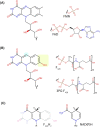


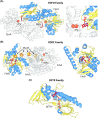
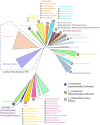


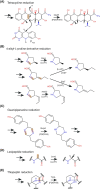
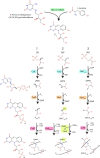
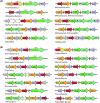
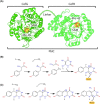


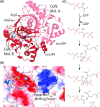




Similar articles
-
Physiology, Biochemistry, and Applications of F420- and Fo-Dependent Redox Reactions.Microbiol Mol Biol Rev. 2016 Apr 27;80(2):451-93. doi: 10.1128/MMBR.00070-15. Print 2016 Jun. Microbiol Mol Biol Rev. 2016. PMID: 27122598 Free PMC article. Review.
-
The methanogenic redox cofactor F420 is widely synthesized by aerobic soil bacteria.ISME J. 2017 Jan;11(1):125-137. doi: 10.1038/ismej.2016.100. Epub 2016 Aug 9. ISME J. 2017. PMID: 27505347 Free PMC article.
-
Redox Coenzyme F420 Biosynthesis in Thermomicrobia Involves Reduction by Stand-Alone Nitroreductase Superfamily Enzymes.Appl Environ Microbiol. 2020 Jun 2;86(12):e00457-20. doi: 10.1128/AEM.00457-20. Print 2020 Jun 2. Appl Environ Microbiol. 2020. PMID: 32276981 Free PMC article.
-
Convergent pathways to biosynthesis of the versatile cofactor F420.Curr Opin Struct Biol. 2020 Dec;65:9-16. doi: 10.1016/j.sbi.2020.05.002. Epub 2020 Jun 20. Curr Opin Struct Biol. 2020. PMID: 32570108 Review.
-
Cofactor F420, an emerging redox power in biosynthesis of secondary metabolites.Biochem Soc Trans. 2022 Feb 28;50(1):253-267. doi: 10.1042/BST20211286. Biochem Soc Trans. 2022. PMID: 35191491
Cited by
-
Evaluation and comparison of antioxidant abilities of five bioactive molecules with C-H and O-H bonds in thermodynamics and kinetics.RSC Adv. 2022 Sep 27;12(42):27389-27395. doi: 10.1039/d2ra04839f. eCollection 2022 Sep 22. RSC Adv. 2022. PMID: 36275999 Free PMC article.
-
Cofactor F420 tail length distribution in different environmental samples.Heliyon. 2024 Oct 9;10(20):e39127. doi: 10.1016/j.heliyon.2024.e39127. eCollection 2024 Oct 30. Heliyon. 2024. PMID: 39640720 Free PMC article.
-
Functions of nitroreductases in mycobacterial physiology and drug susceptibility.J Bacteriol. 2025 Feb 20;207(2):e0032624. doi: 10.1128/jb.00326-24. Epub 2025 Jan 8. J Bacteriol. 2025. PMID: 39772630 Free PMC article. Review.
-
Deletion of fbiC in Streptomyces venezuelae removes autofluorescence in the excitation-emission range of cyan fluorescent protein.Microbiology (Reading). 2025 Apr;171(4):001552. doi: 10.1099/mic.0.001552. Microbiology (Reading). 2025. PMID: 40232129 Free PMC article.
-
Prokaryotic-virus-encoded auxiliary metabolic genes throughout the global oceans.Microbiome. 2024 Aug 29;12(1):159. doi: 10.1186/s40168-024-01876-z. Microbiome. 2024. PMID: 39198891 Free PMC article.
References
-
- Abken H-J, Deppenmeier U. Purification and properties of an F420H2 dehydrogenase from Methanosarcina mazei Gö1. FEMS Microbiol Lett. 1997;154:231–7.
-
- Adam PS, Borrel G, Gribaldo S. An archaeal origin of the Wood–Ljungdahl H4MPT branch and the emergence of bacterial methylotrophy. Nat Microbiol. 2019;4:2155–63. - PubMed
-
- Afting C, Hochheimer A, Thauer R. Function of H2-forming methylenetetrahydromethanopterin dehydrogenase from Methanobacterium thermoautotrophicum in coenzyme F420 reduction with H2. Arch Microbiol. 1998;169:206–10. - PubMed
-
- Ahmed FH, Carr PD, Lee BMet al. . Sequence–structure–function classification of a catalytically diverse oxidoreductase superfamily in Mycobacteria. J Mol Biol. 2015;427:3554–71. - PubMed
Publication types
MeSH terms
Substances
Grants and funding
LinkOut - more resources
Full Text Sources
Other Literature Sources
Molecular Biology Databases

